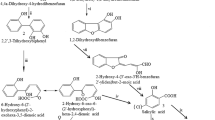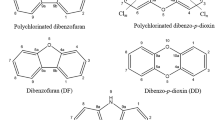Abstract
The dioxin-degrading strain Pseudomonas veronii PH-03 was isolated from contaminated soil by selective enrichment techniques. Strain PH-03 grew on dibenzo-p-dioxin and dibenzofuran as a sole carbon source. Further, 1-chlorodibenzo-p-dioxin, 2-chlorodibenzo-p-dioxin and other dioxin metabolites, salicylic acid, and catechol were also metabolized well. Resting cells of strain PH-03 transformed dibenzo-p-dioxin, dibenzofuran, 2,2′,3-trihydroxybiphenyl, and some chlorodioxins to their corresponding metabolic intermediates such as catechol, salicylic acid, 2-hydroxy-(2-hydroxyphenoxy)-6-oxo-2,4-hexadienoic acid, and chlorocatechols. The formation of these metabolites was confirmed by comparison of gas chromatography–mass spectrometry (GC–MS) data with those of authentic compounds. Although we did observe the production of 3,4,5,6-tetrachlorocatechol (3,4,5,6-TECC) from 1,2,3,4-tetrachlorodibenzo-p-dioxin (1,2,3,4-TCDD) with resting cell suspensions of PH-03, growth of strain PH-03 in the presence of 1,2,3,4-TCDD was poor. This result suggests that strain PH-03 is unable to utilize 3,4,5,6-TECC, even at very low concentration (0.01 mM) due to its toxicity. In cell-free extracts of DF-grown cells, 2,2′,3-trihydroxybiphenyl dioxygenase, 2-hydroxy-6-oxo-6-phenyl-2,4-hexadienoic acid hydrolase, and catechol-2,3-dioxygense activities were detected. Moreover, the activities of meta-pyrocatechase and 2,2′,3-trihydroxybiphenyl dioxygenase from the crude cell-free extracts were inhibited by 3-chlorocatechol. However, no inhibition was observed in intact cells when 3-chlorocatechol was formed as intermediate.
Similar content being viewed by others
References
Adriaens P, Fu Q & Grbic-Galic D (1995) Bioavailabiliy and transformation of highly chlorinated dibenzo-p-dioxins and dibenzofurans in anaerobic soils and sediments. Environ. Sci. Technol. 29: 2252–2250
Arfmann HA, Timmis KN & Wittich RM (1997) Mineralization of 4-chlorodibenzofuran by a consortium consisting of Sphingomonas sp strain R WI and Burkholderia sp strain JWS. Appl. Environ. Microbiol. 63: 3458–3462
Bartels I, Knackmuss HJ & Reineke W (1984) Suicide inactivation of catechol 2,3-dioxygenase from Pseudomonas putita mt-2 by 3-halocatechols. Appl. Environ. Microbiol. 60: 2884–2889
Beurskens JEM, Toussaint M, Wolf J de, Steen JMD van der, Slot PC, Commandeur LCM & Parsons JR (1995) Dehalogenation of chlorinated dioxins by an anaerobic microbial consortium from sediment. Environ. Toxicol. Chern. 14: 939–943
Bradford MM (1976) A rapid and sensitive method for the quantitation of microgram quantities of protein utilizing the principle of protein-dye binding. Anal. Biochem. 72: 248–254
Bunge M, Adrian L, Kraus A, Opel M, Lorenz WG, Andreesen JR, Gorisch H & Lechner U (2003) Reductive dehalogenation of chlorinated dioxins by an anaerobic bacterium. Nature 421: 357–360
Bünz PV & Cook AM (1993) Dibenzofuran 4,4a-dioxygenase from Sphingomonas sp. strain R WI: angular dioxygenation by a three-component enzyme system. J. Bacteriol. 175: 6467–6475
Bünz PV & Schmidt S (1997) The microbial degradation of halogenated diaryl ethers. Biotechnol. Adv. 15: 621–632
Bünz PV, Falchetto R & Cook AM (1993) Purification and characterization of two isofunctional hydro loses in the degradative pathway for dibenzofuran in Sphingomonas sp strain RWI. Biodegradation 4: 171–178
Cerniglia CE, Morgan JC & Gibson DT (1979) Bacterial and fungal oxidation of dibenzofuran. Biochem J. 180: 175–185
Fortnagel P, Harms H, Wittich RM, Krohn S, Meyer H, Sinnwell V, Wilkes H & Francke W (1990) Metabolism of dibenzofuran by Pseudomonas sp. strain HH69 and the mixed culture HH27. Appl. Environ. Microbiol. 56: 1148–1156
Habe H, Chung JS, Lee JH, Kasuga K, Yoshida T, Nojiri H & Omori T (2001) Degradation of chlorinated dibenzofurans and dibenzo-p-dioxins by two types of bacteria having angular dioxygenases with different features. Appl. Environ. Microbiol. 67: 3610–3617
Halden RU & Dwyer DF (1997) Biodegradation of dioxinrelated compounds: a review. Bioremed. J. I: 11–25
Happe B, Eltis LD, Poth H, Hedderich R & Timmis KN (1993) Characterization of 2,2',3-trihydroxybiphenyl dioxygenase, an extradiol dioxygenase from the dibenzofuran-and dibenzo-p-dioxin-degrading bacterium Sphingomonas sp. strain RWI. J. Bacteriol. 175: 7313–7320
Hong HB, Chang YS, Choi SD & Park YH (1999) Degradation of dibenzofuran by Pseudomonas putida PH-Ol. Water Res. 34: 2404–2407
Hong HB, Chang YS, Nam IH, Schmidt S & Fortnagel P (2002) Biotransformation of 2,7-dichloro-and 1,2,3,4-tetrachlorodibenzo-p-dioxin by Sphingomonas wittichii RWI. Appl. Environ. Microbiol. 68: 2584–2588
Kaschabek SR, Kasberg T, Muller D, Mars AE, Janssen DB & Reineke W (1998) Degradation of chloroaromatics: purification and characterization of novel type of chlorocatechol 2,3dioxygenase of Pseudomonas putida G131. J. Bacteiol. 180: 296–302
Keim T, Francke W, Schmidt S & Fortnagel P (1999) Catabolism of 2,7-dichloro-and 2,4,8-trichlorodibenzofuran by Sphingomonas sp. strain RWI. J. Ind. Microbiol. Biotechnol. 23: 359–363
Kimura N & Urushigawa Y (2001) Metabolism of dibenzo-p-dioxin and chlorinated dibenzo-p-dioxin by a gram-positive bacterium Rhodococcus opacus SAOIOI. J. Biosci. Bioeng. 92: 138–143
Klecka GM & Gibson DT (1979) Metabolism of dibenzo-p-dioxin by a Pseudomonas species. Biochem. J. 180: 639–645
Klecka GM & Gibson DT (1980) Metabolism of dibenzo-p-dioxin and chlorinated dibenzo-p-dioxins by a Beijerinckia species. Appl. Environ. Microbiol. 39: 288–296
Klecka GM & Gibson DT (1981) Inhibition of catechol 2,3dioxygenase from Pseudomonas putida by 3-chlorocatechol. Appl. Environ. Microbiol. 41: 1159–1165
Kohler HP, Schmid A & van der Maarel M (1993) Metabolism of 2,2'-dihydroxybiphenyl by Pseudomonas sp. Strain HBPI: production and consumption of 2,2',3-trihydroxybiphenyl. J. Bacteriol. 175: 1621–1628
Mars AE, Kasberg T, Kaschabek SR, van Agteren MH, Janssen DB & Reineke W (1997) Microbial degradation of chloroaromatics: use of the meta-cleavage pathway for mineralization of chlorobenzene. J. Bacteriol. 179: 4530–4537
Mars AE, Kingma J, Kaschabek SR, Reineke W & Janssen DB (1999) Conversion of 3-chlorocatechol by various catechol 2,3-dioxygenases and sequence analysis of the chlorocatechol dioxygenase region of Pseudomonas putida G13I. J. Bacteriol. 181: 1309–1318
Meharg AA & Osborn D (1995) Dioxins released from chemical accidents. Nature 375: 353–354
Monna L, Omori T & Kodama T (1993) Microbial degradation of dibenzofuran, fluorene, and dibenzo-p-dioxin by Staphylococcus auriculans DBF63. Appl. Environ. Microbiol. 59: 285–289
Nam IH, Chang YS, Hong HB & Lee YE (2003) A novel catabolic activity of Pseudomonas veronii in biotransformation of pentachlorophenol. Appl. Microbiol. Biotechnol. 62: 284–290
Nojiri H, Habe H & Omori T (2001) Bacterial degradation of aromatic compounds via angular dioxygenation. J. Gen. Appl. Microbiol. 47: 279–305
Nokazawa T & Nokazawa A (1970) Pyrocatechase (Pseudomonas). Meth. Enzymol. 17A: 518–522
Nozaki M (1970) Metapyrocatechase (Pseudomonas). Meth. Enzymol. 17A: 522–525
Oh JE, Lee KT, Lee JW & Chang YS (1999) The evaluation of PCDD/Fs from various Korean incinerators. Chemosphere 38: 2097–2108
Omori T, Sugimura K, Ishigooka H & Minoda Y (1986) Purification and some properties of a 2-hydroxy-6-oxo-6phenylhexa-2,4-dienoic acid hydrolyzing enzyme from Pseudomonas cruciviae S93 BI involved in the degradation of biphenyl. Agric. BioI. Chem. 50: 931–937
Parsons JR & Storms MCM (1989) Biodegradation of chlorinated dibenzo-p-dioxins in batch and continuous cultures of strain JBI. Chemosphere 19: 1297–1308
Pearson WR & Lipman DJ (1988) Improved tools for biological sequence comparison. Proc. Natl. Acad. Sci. USA 85: 2444–2448
Pollitt F (1999) Polychlorinated dibenzodioxins and polychlorinated dibenzofurans. Regul. Toxicol. Pharm. 30: S63-S68
Schreiner G, Wiedmann T, Schimmel H & Ballschmiter K (1997) Influence of the substitution pattern on the microbial degradation of mono-to tetrachlorinated dibenzo-p-dioxins and dibenzofurans. Chemosphere 34: 1315–1331
Shin WY, Doucette W, Frank APCG, Andren A & Donald M (1988) Physical chemical properities of chlorinated dibenzo-p-dioxins. Environ. Sci. Technol. 22: 651–658
Wilkes H, Francke W, Wittich RM, Harms H, Schmidt S & Fortnagel P (1992) Mechanistic investigation on microbial degradation of diaryl ethers — analysis of isotope-labelled reaction products. Naturwissenschaften 79: 269–271
Wilkes H, Wittich RM, Timmis KN, Fortnagel P & Francke W (1996) Degradation of chlorinated dibenzofurans and dibenzo-p-dioxins by Sphingomonas sp. strain RWI. Appl. Environ. Microbiol. 62: 367–371
Wittich RM (1998) Degradation of dioxin-like compounds by microorganisms. Appl. Microbiol. Biotechnol. 49: 489–499
Wittich RM, Wilkes H, Sinnwell V, Francke W & Fortnagel P (1992) Metabolism of dibenzo-p-dioxin by Sphingomonas sp. strain RWI. Appl. Environ. Microbiol. 58: 1005–1010
Author information
Authors and Affiliations
Rights and permissions
About this article
Cite this article
Hong, HB., Nam, IH., Murugesan, K. et al. Biodegradation of Dibenzo-p-dioxin, Dibenzofuran, and Chlorodibenzo-p-dioxins by Pseudomonas veronii PH-03. Biodegradation 15, 303–313 (2004). https://doi.org/10.1023/B:BIOD.0000042185.04905.0d
Issue Date:
DOI: https://doi.org/10.1023/B:BIOD.0000042185.04905.0d




